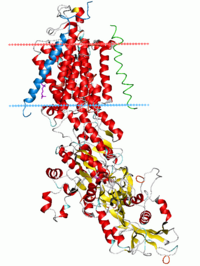
Photo from wikipedia
Potassium is a very commonly measured electrolyte across many fields of medicine, including cardiology. The normal range of serum potassium is typically cited as 3.5–5.0 mmol/L. However, several recent Danish… Click to show full abstract
Potassium is a very commonly measured electrolyte across many fields of medicine, including cardiology. The normal range of serum potassium is typically cited as 3.5–5.0 mmol/L. However, several recent Danish publications suggest that the optimal range of serum potassium is much narrower than the normal range in several conditions including acute heart failure after myocardial infarction1 and chronic heart failure.2 These papers — which use data through 2012 — report serum potassium; however, beginning in 2010, some Danish laboratories changed from measuring serum potassium to plasma potassium, thus there was likely a mixture of serum potassium and plasma potassium values in the dataset used by the researchers in Denmark. This introduces some uncertainty regarding the potassium value for the nadir of risk in the U-shaped relationship between serum/plasma potassium and risk. Similarly, in the healthcare system of Stockholm region some centres measure potassium in serum while others measure potassium in plasma, and some centres have changed from one to the other in recent years.3 Having both values appear in clinical and research databases may impact research in this area and has implications for clinical care. This would be a trivial matter if not for the often overlooked fact that the optimal range differs depending on whether the measurement is derived from a serum or plasma sample. Serum measurements require blood clotting before analysis while plasma measurements are done directly after drawing the sample. Potassium is continuously released from cells during clotting. Therefore, imperfect sampling conditions, such as traumatic venipuncture, temperature variation, and prolonged time from collection to processing, can result in higher serum potassium levels, but would have less effect on plasma potassium levels. However, haemolysis and stasis also affect plasma potassium. This realization potentially diminishes the impact of any results or conclusions drawn from datasets which use clinically-derived potassium values, particularly datasets which have a combination of both serum and plasma samples. The Nordic Reference Interval Project (NORIP) reported in the year 2000 that the normal reference range for serum potassium was 3.6–4.6 mmol/L and the normal reference range for plasma potassium was 3.5–4.4 mmol/L.4 NORIP investigators performed additional analyses in which they excluded samples that deviated from results from the same individual, and found that the reference values remained unchanged, suggesting haemolysis did not substantially impact these results.5 These optimal values for serum and plasma potassium are similar, but NORIP was considered to have optimally collected and processed samples which minimized clotting effects on potassium, and excluded patients from whom it was difficult to draw blood samples. Samples were collected according to strict standards and instructions, as documented previously.6 Very early work reported that in real-world clinical conditions, potassium concentration determined from a coagulated blood sample can be 0.1 to 0.4 mmol/L higher than that measured in an anticoagulated plasma sample.7 Laboratories can quantify haemolysis but cannot correct for this and other factors that impact sample integrity.8 In the field of heart failure, potassium regulation within a normal range is particularly important, as both high and low potassium levels are associated with worse outcomes.9 In addition, treatments for heart failure, including diuretics and renin–angiotensin–aldosterone system (RAAS) inhibitors, and co-morbidities in heart failure, such as chronic kidney disease, all affect potassium levels. Importantly, treatments are often altered in response to potassium levels, such as replenishing potassium, discontinuing RAAS inhibitors, or using potassium binders. Thus, failing to consider the source (plasma or serum) of potassium determination may result in unnecessary or even inappropriate treatment decisions.
Journal Title: European Journal of Heart Failure
Year Published: 2019
Link to full text (if available)
Share on Social Media: Sign Up to like & get
recommendations!